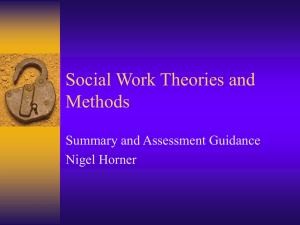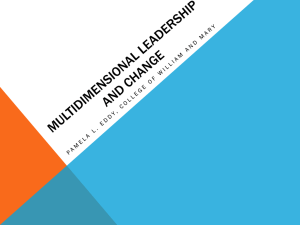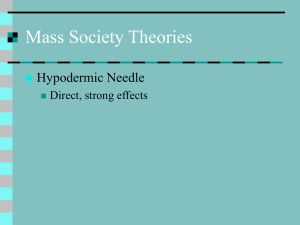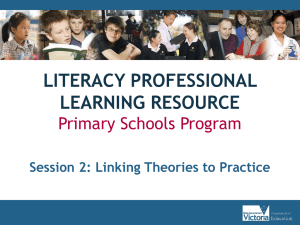Career 1
advertisement
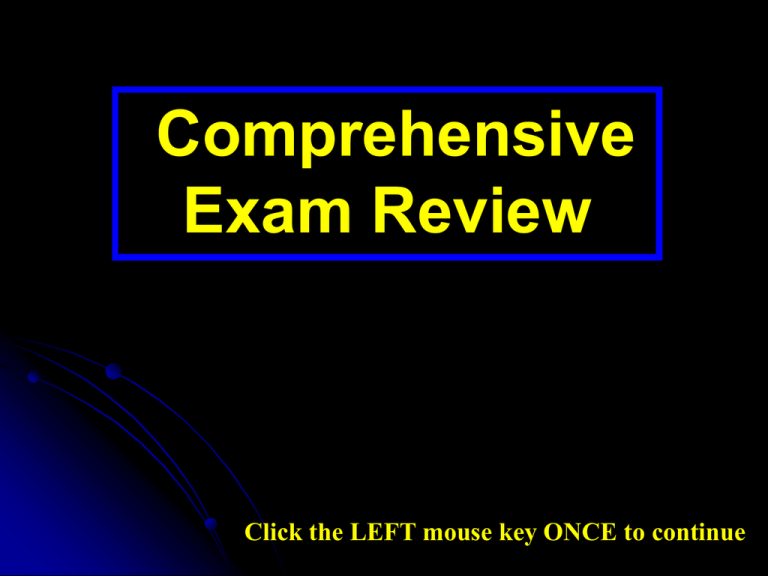
Comprehensive Exam Review Click the LEFT mouse key ONCE to continue Career and Lifestyle Development Part 1 Click the LEFT mouse key ONCE to continue Career Development Theories and Decision-Making Models In order to understand career development theories and decision-making models, it is important to be familiar with the basic terms used in this field. Although different theories and models may put a specific "spin" on a particular term, a common understanding of terms has evolved over the years that allows professionals to communicate effectively irrespective of the theory or model they use in practice. Beginning counselors and the general public are often imprecise in their use of terms. For example, the terms "occupation," "job," and "position" are sometimes (erroneously) used as synonyms. To avoid confusion and miscommunication with clients or each other, counselors need to use terms that accurately reflect the aspect of the career development process that they are describing. Following are common terms used in discussion of career development. By viewing the "big picture," the reader can be better prepared to understand the use of specific terms. Career - The interrelationships among an individual's paid work, unpaid work, leisure, family, education, and training that evolve over time. Often defined previously as the sequence of occupations held by an individual over a lifetime, now the term is typically viewed in a broader, more holistic manner. Career counseling - A process where a client and counselor identify a career problem, set goals for resolving the problem, and then use a variety of assessment, information, and instructional resources (within the context of a helping relationship) to resolve the problem. Career counseling is one component of a fully functional career guidance program and is used most cost-effectively for clients with limited readiness for career choice or with complicated career problems. Career decision making - A process of identifying that a decision needs to be made, generating options, examining self and options, selecting an option, and planning needed action to follow through with the decision. Career development - The internal and external factors that influence a person's career development over time. Career development can be planned, purposeful, reactive, or random. Career guidance, career education, career counseling, career interventions, and career management are intended to help individuals have healthy, successful careers by proactively dealing with the factors that influence career development. Career education - An education-community partnership to integrate assessment, information, and instructional resources for students at developmentally appropriate times, from elementary school through postsecondary education, to proactively influence students' career development. Instruction is a key element of the career education process. Career guidance - A comprehensive strategy (including career education and counseling, self-help resources, and job placement) designed to help individuals access and use assessment, information, and instructional resources in a developmentally appropriate manner to enhance career development. Although the focus shifts to career management once an individual becomes employed, career guidance services may be sought as individuals negotiate ongoing employment, education, and training opportunities. Career intervention - The use of assessment, information, and instructional resources to solve a career problem, with or without the assistance of a practitioner. A career intervention can be as simple as an individual's use of self-help career information or as complex as the exploration of interrelated work and family problems in individual career counseling. Career ladder - A series of jobs within an organization with increasing complexity and diverse skill requirements designed to prepare workers for upward mobility and greater responsibility. Career lattice - A series of jobs within an organization that allow upward or lateral transfers. It can include a number of career ladders, thus allowing workers to transfer laterally, and help them to continue to develop skills and remain motivated when upward mobility is limited. Career management - Actively assuming responsibility for one's ongoing career development by proactively using supervision, career resources, and educational and training opportunities to maximize career success. Individuals seeking to manage their careers may make use of career counseling, career guidance, career interventions, or job placement assistance to help them make career, occupational, educational, training, or employment decisions. Job - A paid position held by one or more persons requiring similar attributes in one organization. Occupation - A group of jobs with similar characteristics that can be found in different employing organizations. A “professional” also will have common training and experience requirements for entry. Leisure - Self-determined physical, social, intellectual, volunteer, or creative efforts and experiences that allow the pursuit of interests and the use of abilities. Job placement - A process of translating career aspirations into employment within an organization. Components of job placement services typically include job-search training and access to position openings. Ideally, job placement efforts are built upon the foundation of earlier learning and problem solving promoted by the use of assessment, information, and instructional resources provided in career guidance. Position - A group of tasks performed by one individual in an organization. Work - Paid or unpaid effort to accomplish a goal valued by the individual or others. The purpose may include the inherent satisfaction of completing the tasks involved, the structure it provides for living, and the economic benefits. Numerous internal and external factors interact to influence career development and career decision making. These factors often make the process of career decision making seem overwhelming to clients (and sometimes to counselors). Theories of career development and decision making help to make the process manageable. Career theories have been developed by theorists to accomplish various goals. Some career theories are closely related to another theory (e.g., social learning theory) and seek to explain career events using the other theory. Others are constructed to help explain a particular issue or problem (e.g., underrepresentation of women in particular occupations). Some theories integrate elements from several theories, e.g., Super, while others are more narrowly constructed, e.g., Holland. Career theory provides counselors and clients with tools for understanding and managing career choice. Career theory clarifies factors that influence career development, which helps counselors respond to client questions about career problems. No one single theory has been recognized as adequate for all clients and counselors. Counselors select career theories that are congruent with their own views of career development and that have evidence of validity and utility. While some counselors are guided by a single theory, more often counselors integrate several different theoretical principles into their career work with clients. Some theories are important for historical reasons, while other theories are currently popular in guiding practice. Frank Parsons initiated the practice of career guidance at the turn of the century, and his ideas became the basis of Trait-and-Factor theory developed by E.G. Williamson. Parsons believed career choice involved knowledge of self and occupations, and analyzing the fit between the individual and the occupation (Parson’s "true reasoning"). Trait-and-Factor theory involved matching traits (most often aptitude and interests) with the requirements of a specific occupation. The use of assessment instruments is a major resource in this theoretical perspective. Roe, Ginzberg, and Tiedeman also made important contributions to the understanding of career development. Roe explored family influences on career development and developed a schema for categorizing occupations by type and level. Ginzberg and his associates created a developmental theory with specific sequential periods and stages that describe the process of career development. Tiedeman created a developmental theory focused on anticipation or preoccupation (exploration, crystallization, choice, and clarification) and implementation or adjustment (induction, reformation, and integration). These theories are less popular today, but have had an important influence on understanding the nature of career development. New career theories continue to emerge. Constructivist and cognitive-based approaches are common current trends in career theory. A common criticism of the research upon which much career theory is built is that the subjects were white, middle-class males, which actually reflected the labor market of those times (1930s - 1950s). While agreement exists that white middleclass males were overrepresented in the research, disagreement exists as to whether the theories created at that time can be used successfully with women, people of color, or persons of low socioeconomic status. Some have argued that the unique experience of specific groups requires specific theories in order to best help those individuals with career choices. Others have argued that the process of career exploration, the negative influence of stereotyping, and the process of decision making are common enough across groups to make career theory generally applicable. Remembering the purpose of using career theory (i.e., helping counselors and clients to understand and manage career choice), the counselor is responsible for selecting one or more theories that are appropriate for the characteristics of the client. The popularity of various career theories can be judged in two ways. First is the number of citations in the literature where the theory is used to (a) explore various aspects of career development or (b) as a basis for service delivery with various populations. Second is the availability and reported use of theory-based assessment, information, and instructional resources in practice. By these two criteria, the work of Holland, Super, Krumboltz, and Dawis and Lofquist are currently four of the most popular career theories. Holland stated that both individuals and work environments can be categorized as realistic, investigative, artistic, social, enterprising, and conventional. This model is represented as a hexagon, with individuals and work environments commonly categorized by the three most similar codes. Satisfaction and success in work is strongly influenced by the congruence between the personality of the individual and the characteristics of the work environment. Several important constructs influence an individual's career decision making. These constructs, which include consistency, differentiation, identity, commonness, and coherence of aspirations, can be used to help the client and counselor better understand the nature of the client’s career problems and how much help the client is likely to need. Holland and others have created assessments related to interests, vocational identity, career attitudes and strategies, and employment positions based on this theory. Super stated that the implementation of selfconcept is a key factor that influences career development over the life span. Individuals cycle and recycle through the developmental stages of growth, exploration, establishment, maintenance, and decline. Individuals also progress through the developmental tasks of crystallization, specification, implementation, stabilization, and consolidation. Research by Crites and others helped to establish that the career maturity of adolescents and the career adaptability of adults are useful constructs in identifying who is more likely to experience problems in completing career development tasks. Super's life rainbow can be used to help clients understand evolving interaction among the life roles of child, student, leisurite, citizen, worker, spouse, homemaker, parent, or pensioner. These concepts are especially relevant as adults attempt to maintain balance in life roles as various work and life changes occur. Super and others created assessments relevant to career maturity, values, work salience, and adult career concerns. Krumboltz stated that career decision making is influenced by the following factors: genetic endowments and special abilities, environmental conditions and events, learning experiences (instrumental and associative), and task approach skills (such as problem solving). The outcomes of these factors include selfobservation and worldview generalizations, and actions. Beliefs about self or the world in the form of private rules can either help or hinder the process of career decision making. Challenging the validity of inappropriate private rules is an important role for the counselor in career counseling, as is promoting information-seeking behavior in career exploration, including modeling and reinforcement. Krumboltz created a measure of career beliefs that counselors can use to facilitate clients' career decision making. Dawis and Lofquist stated that job stability and satisfaction are a function of the correspondence between the individual and the work environment. The individual must successfully fulfill the requirements of the job, while the work environment must fulfill the needs of the individual. A variety of occupational reinforcers in the work environment contribute to the work adjustment of individuals. Job satisfaction is also a significant indicator of work adjustment. Dawis and Lofquist created assessments, such as a measure of work values, to aid the translation of their theory into practice. Career Information and Resources Information resources need to reflect the broad definition of career described previously (i.e., the interrelationships among an individual's paid work, unpaid work, leisure, family, education, and training). While occupational and educational information is the most commonly available information source for career decision making, information related to leisure and family issues is needed to support an effective career guidance program. Information can be used to motivate individuals to engage in career exploration (e.g., an engaging biography or presentation of a work environment may motivate an individual to explore potentially satisfying occupations). Information can be used to clarify or raise an individual's occupational aspirations (e.g., a presentation of the relationship between educational level and earnings may cause an individual to reconsider dropping out of school in favor of training necessary for a high-wage job). Information can be used to clarify an individual's perceptions of his or her values, interests, and skills (e.g., reading descriptions of the leisure time associated with occupations can cause an individual to increase the value of leisure in evaluating career options). Information can be used to narrow the range of options being considered (e.g., potential employment opportunities for a spouse can be used as a factor in evaluating job offers). Information can be used to support the job placement process, e.g., individuals may prepare for job interviews by reviewing occupational information to better understand the recruitment materials. It is important to understand the purpose of using information resources in the careerdecision making process before recommending specific information for client use. After determining the types of information needed by the client, it is important to consider the type of media that will promote the best learning outcomes for the client. Media sources can be classified as noninteractive or interactive. Noninteractive media are generally linear in nature, with their structure influencing the selection and sequencing of information presented. Noninteractive media typically provide extensive information at a moderate cost. Examples of non-interactive media include: Print (books, pamphlets, brochures, and files); Microform (microfiche, microfilm, and microbooks); Audio (commercial or locally produced audio tapes or broadcast radio programs); Audiovisual (commercially and locally produced videotape programs and broadcast television); and Public presentations (speeches and panel discussions with audience participation). Interactive media is generally non-linear in nature with the individual maintaining at least partial control over the selection and sequencing of information dissemination. Most interactive media are motivating for the individual to use, but often are more expensive than noninteractive media. Examples of interactive media include: Computer-assisted career guidance systems or computer-based career information delivery systems (include assessment, search for options, and information dissemination elements); Computer-assisted instruction (instruction in resume preparation); Videodisks or CD-ROMS (interviews with employed workers for individuals with limited reading abilities); Programmed instruction (job experience kit that provides the opportunity to perform actual job tasks); Structured interview (interviewing a currently employed worker at the job site or at a career day); Role playing or games (guidance activity that allows students to try out career and life options); Instruction (classroom activities that allow individuals to try out various work behaviors, e.g., accounting); Direct observation (shadowing a worker for a day or taking field trips to places of employment); and Direct exploration (volunteer work, cooperative education, internships, work-study programs, or part-time employment). There also are numerous public sources of career information, such as State and/or National Occupational Information Coordinating Committees and state and U. S. Departments of Labor. In many cases, multiple information resources are relevant to a client's needs. The learning potential of a resource often can be enhanced by proper sequencing. For example, it is best to use the information interview to ask questions not typically provided in occupational descriptions or questions uniquely related to an individual's needs. Some clients may need assistance in actually locating information in a career center library or on the Internet; therefore, counselors need to be familiar with the location of commonly used information resources. Counselors also need to be aware of options for delivering information resources in alternative formats for individuals with a disability. Individuals with high decision-making readiness (high levels of career maturity, vocational identity, or decidedness) will need less assistance in using information resources than individuals with low decision-making readiness. Individuals with low decision-making readiness (low levels of career maturity, vocational identity, or decidedness) will generally need more careful introduction and follow-up to information use. Occupational information often is easier to use when the occupations are organized according to a classification system. Examples of classification systems include Holland types, the ACT World-of-Work map, and worker-trait groups. Occupational information should meet a specific need and be valid, current, understandable for the intended client population, easy to use, and free of stereotypes. Career Development Programming A career (development) program is a system of interrelated resources and services designed to help a defined group of individuals solve career problems and make career decisions effectively. Developing a career program includes the following steps: 1. 2. 3. 4. Establish a need for the program. Establish a conceptual basis. Establish goals and objectives. Select career resources and services that are likely to assist individuals in achieving appropriate goals and objectives. 5. Select strategies to evaluate the effectiveness of the program. Several sources of information can be used to establish a conceptual basis for a career program. First, career theory can be used to suggest program goals and objectives appropriate for various populations and guide the selection of theory-based resources and service delivery strategies. Second, descriptive research data can be used to better understand the career development needs of various populations, understanding which, in turn, can be used to establish program goals and objectives that better meet the needs of individuals. Also, outcome evaluation data from prior career programs can be used in selecting resources and services that have been demonstrated to be effective with specific populations. Third, existing standards can be used to identify developmental outcomes for individuals at various ages, which helps in establishing program goals and objectives. The ability of individuals to benefit from career resources and services depends upon the level of staff support provided being congruent with individuals' needs. An effective career program is organized to deliver a combination of self-help, brief, staff-assisted, or individual, case-managed interventions. The following factors often influence the success of career programs: 1. 2. 3. 4. Staff participation in decision making; Support from senior managers; Effective communication among staff; Efective integration of the new program with existing career resources and services; 5. Effective staff training; and 6. Integration of program evaluation data for continuous improvement. Program administration requires a number of skills that are not typically emphasized in counselor training programs, such as budgeting, personnel regulations, non-clinical supervision, etc. The delivery of quality career counseling services to clients, however, requires that someone in the organization attend to these matters. This concludes the Part 1 of presentation on CAREER AND LIFESTYLE DEVELOPMENT

